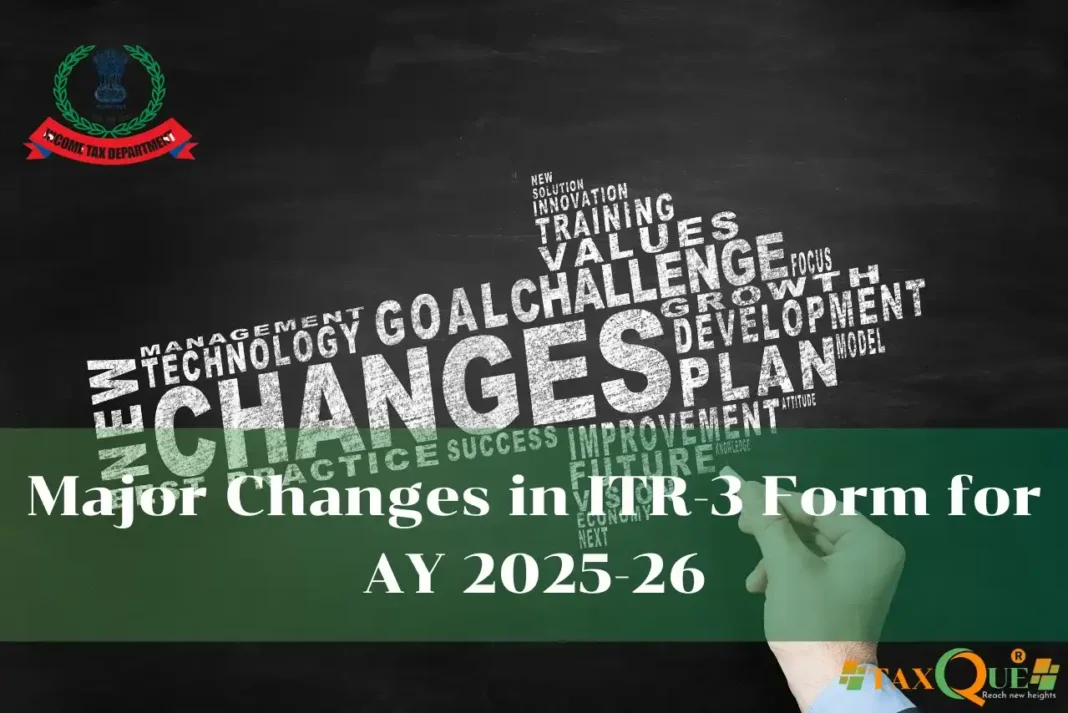ITR-3 Form for AY 2025-26: What’s New?
The Central Board of Direct Taxes (CBDT) has notified significant updates in the ITR-3 Form for AY 2025-26, applicable to individuals and Hindu Undivided Families (HUFs) earning income from business or profession. These changes aim to improve compliance, increase transparency, and support the digitization of the Indian tax system.
Let’s explore the major updates and compare them with the previous year’s ITR-3.
📊 Comparative Table: Key Changes in ITR-3 Form
| Feature | AY 2024-25 | AY 2025-26 |
|---|---|---|
| New Tax Regime (Sec 115BAC) | Limited reporting | Detailed options with Form 10-IEA mandatory |
| Residential Status | Basic categories | Expanded per Finance Act 2020 & 2021 |
| Audit Details | General info | Now includes UDIN, acknowledgment no., date |
| Presumptive Tax (44AD/ADA) | ₹2 Cr / ₹50 Lakh | ₹3 Cr / ₹75 Lakh if cash receipts ≤ 5% |
| Seventh Proviso (139(1)) | Basic checkboxes | Requires exact amounts and category selection |
| Unlisted Shares & Directorships | Optional fields | Mandatory disclosure with PAN, DIN, share details |
| Foreign Establishments | Not emphasized | Specific fields for PE, SEP, jurisdiction of residence |
| ICDS Adjustments | Mentioned briefly | Separate fields for deviations and disclosures |
| IFSC Units & FPI Details | Not included | New reporting for IFSC income and SEBI registration |
🧮 Key Highlights from the New ITR-3 Form
✅ 1. Opting Out of New Tax Regime
- A taxpayer must now disclose their intent to opt out under Section 115BAC(6).
- Must submit Form 10-IEA before the due date under Section 139(1).
- Details required: Acknowledgement number and date of filing.
Example: A professional who opted out in AY 2024-25 must now indicate whether they wish to continue in AY 2025-26, and provide Form 10-IEA proof.
🌍 2. Expanded Residential Status Criteria
Includes nuanced residential conditions such as:
- Indian citizens visiting India (120 days + ₹15 lakh income threshold).
- Deemed residency under Section 6(6)(d) for individuals not taxed in any other country.
💼 3. Mandatory Audit Details
- Audit report details must include:
- Auditor’s name, membership number, PAN, UDIN.
- Acknowledgment number of the audit report.
- Applicable under Section 44AB, 92E, or other audit provisions.
🏦 4. Seventh Proviso Reporting
If return is filed voluntarily under 7th proviso to Section 139(1), the following details must be provided:
- Deposits > ₹1 crore in current accounts.
- Foreign travel expenses > ₹2 lakh.
- Electricity bills > ₹1 lakh.
📈 5. Enhanced Presumptive Taxation Rules
New turnover limits:
- Section 44AD (Business): ₹3 Crore
- Section 44ADA (Professionals): ₹75 Lakh
(Applicable only if cash receipts do not exceed 5% of total receipts.)
📃 6. Disclosure of Unlisted Shares & Directorship
- Must declare:
- Number of shares held, acquired, or transferred.
- PAN of company.
- DIN (if director).
- Disclosure of equity cost and consideration required.
📌 Why These Changes Matter
These updates reflect the government’s drive for deeper data reporting, greater transparency, and integration with the digital economy. The stricter audit and residency disclosures especially help combat tax avoidance and enforce global compliance (BEPS norms).
FAQs: ITR-3 Form for AY 2025-26
Q1. Who should file ITR-3 for AY 2025-26?
A: Individuals or HUFs having income from business or profession, excluding those eligible for ITR-1 or ITR-2.
Q2. Is Form 10-IEA mandatory for opting out of the new tax regime?
A: Yes, if the taxpayer has business/profession income. It must be filed before the due date.
Q3. Are there any benefits for IFSC unit income disclosure?
A: Yes, IFSC income earned in foreign exchange may be exempt under certain provisions.
Conclusion
The ITR-3 Form for AY 2025-26 comes packed with vital updates for professionals, business owners, and high-net-worth individuals. Ensure timely compliance and seek expert guidance if needed, especially for matters related to Form 10-IEA, audit disclosures, or residency.





